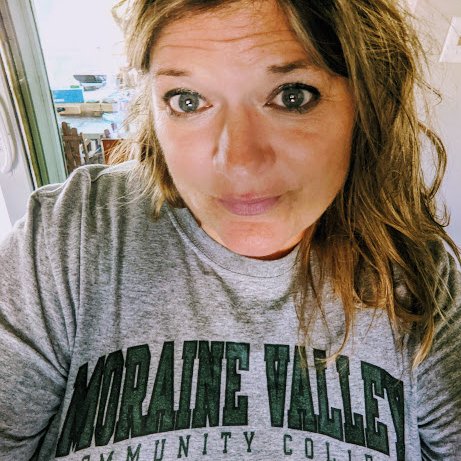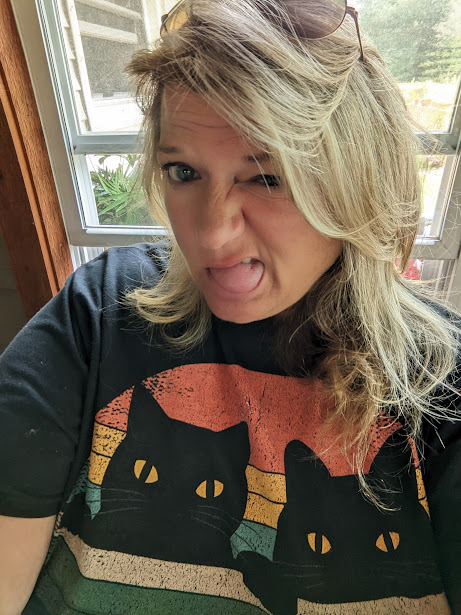Join me at 1pm, cst, to discuss social explanations of delinquent behavior.
THINKING CHALLENGE: How are juveniles more vulnerable to their social environment?
#CRJ107 #SocialStructure
THINKING CHALLENGE: How are juveniles more vulnerable to their social environment?
#CRJ107 #SocialStructure
We are back from campus, at the 'criminal justice from the kitchen' home office to discuss some social aspects of #JuvenileDelinquency, are we ready to get started?
#CRJ107 #SocialStructure
#CRJ107 #SocialStructure

How man @morainevalley shirts do I have???
Infinite. The multiply in my closet, I swear.
Apparently I also love a good selfie 😂😂😂
Infinite. The multiply in my closet, I swear.
Apparently I also love a good selfie 😂😂😂

But back to business! We examined Biological & Psychological explanations. We dabbled in gender. Those explanations focus on the individual delinquent. We are now going to shift our focus on a social approach
#CRJ107 #SocialStructure #Chapter05
#CRJ107 #SocialStructure #Chapter05

Four major types of social theories of delinquency are:
~ social structure theories,
~ social process theories,
~ life course theories,
~ and social reaction theories
#CRJ107 #SocialStructure
~ social structure theories,
~ social process theories,
~ life course theories,
~ and social reaction theories
#CRJ107 #SocialStructure

THINKING CHALLENGE: Of the theories to be discussed this week, which do you find to be the most of interest?
#CRJ107 #SocialStructure
#CRJ107 #SocialStructure
THINKING CHALLENGE: Of the theories to be discussed this week, which do you find to have the most impact to delinquency?
#CRJ107 #SocialStructure
#CRJ107 #SocialStructure
Social structure theories focus on two major factors that influence delinquency: socioeconomic conditions and cultural values
#CRJ107 #MoraineValley #SocialDisorganization
#CRJ107 #MoraineValley #SocialDisorganization

Social structure theories examine why lower-class youths are more likely to commit crime than middle- and upper-class youths
#CRJ107 #MoraineValley #SocialDisorganization
#CRJ107 #MoraineValley #SocialDisorganization

If we are going to look at Social Disorganization Step by Step: Step 01: Poverty
#CRJ107 #MoraineValley #SocialDisorganization



#CRJ107 #MoraineValley #SocialDisorganization




Social Disorganization Step by Step: Step 02: Breakdown of formal institutions
#CRJ107 #MoraineValley #SocialDisorganization
#CRJ107 #MoraineValley #SocialDisorganization

Social Disorganization Step by Step: Step 03: Breakdown of social control
#CRJ107 #MoraineValley #SocialDisorganization
#CRJ107 #MoraineValley #SocialDisorganization

Social Disorganization Step by Step: Step 04: Criminal Areas begin to develop
#CRJ107 #MoraineValley #SocialDisorganization
#CRJ107 #MoraineValley #SocialDisorganization

Social Disorganization Step by Step: Step 05: Crime is normalized, maybe not accepted, but seen as an insurmountable challenge
#CRJ107 #MoraineValley #SocialDisorganization
#CRJ107 #MoraineValley #SocialDisorganization

Social Disorganization Step by Step: Step 06: Criminal Careers Develop
#CRJ107 #MoraineValley #SocialDisorganization
#CRJ107 #MoraineValley #SocialDisorganization

Strain theory states crime is a function of conflict between people’s goals & the opportunity to achieve those goals
#CRJ107 #MoraineValley #StrainTheory
#CRJ107 #MoraineValley #StrainTheory

The third major type of social structure theory is subculture theory. A subculture is a set of values, norms, and beliefs that differs from those within the dominant culture
#CRJ107 #MoraineValley #SubcultureTheory
#CRJ107 #MoraineValley #SubcultureTheory

According to the subculture theory, delinquent youth hold values, norms, and beliefs in opposition to those held in the dominant culture
#CRJ107 #MoraineValley
#CRJ107 #MoraineValley

THINKING CHALLENGE: In what ways do you believe youth culture diverges most dramatically from "dominant" culture today?
Attitudes towards ...
#CRJ107 #MoraineValley
Attitudes towards ...
#CRJ107 #MoraineValley
How well do YOU know our youth of today? What group do you consider yourself?
#CRJ107 #MoraineValley
#CRJ107 #MoraineValley
Let's test your knowledge/assumptions about today's youth.
Myth/Reality: "Gen Z has a negative outlook on the future of the environment"
#CRJ107 #MoraineValley
Myth/Reality: "Gen Z has a negative outlook on the future of the environment"
#CRJ107 #MoraineValley
Myth/Reality: "Gen Z is concernedly vulnerable to social media & influencer culture"
#CRJ107 #MoraineValley
#CRJ107 #MoraineValley
Why are these differences important? Real or imaginary, each generation often defines itself by it's differences from it's predecessors
#CRJ107 #MoraineValley
#CRJ107 #MoraineValley

By simply function of age, many young people can feel isolated or separate from "mainstream" society.
#CRJ107 #MoraineValley
#CRJ107 #MoraineValley

Then we can add additional challenges in society, poverty, access to education, opportunities for financial literacy & success ... which multiply isolation for young people
#CRJ107 #MoraineValley


#CRJ107 #MoraineValley



Youths in rebellion of dominant culture often experience "Status Frustration", a sense of anger, isolation, outsider experience to mainstream society
#CRJ107 #MoraineValley
#CRJ107 #MoraineValley

Middle Class Measuring Rods cause status frustration. The school system favors middle-class dress, mannerisms, and etiquette.
#CRJ107 #MoraineValley
#CRJ107 #MoraineValley

Subcultural theories argue that strain is NOT structural, but interpersonal, located at the level of group interaction
#CRJ107 #MoraineValley
#CRJ107 #MoraineValley

Cloward and Ohlin (1960) believe that many individuals aspire to a middle class lifestyle many others simply want money without having to improve their lifestyle or change their present social class membership.
#CRJ107 #MoraineValley
#CRJ107 #MoraineValley

More than 40 years ago, Walter MILLER identified conduct norms, known as “focal concerns” that help define lower-class culture.
#CRJ107 #MoraineValley
#CRJ107 #MoraineValley

I highly recommend the @frontlinepbs documentary "The Interrupters", featuring @AmeenaMatthews
pbs.org/wgbh/frontline…
#MoraineValley #CRJ107
pbs.org/wgbh/frontline…
#MoraineValley #CRJ107
THINKING CHALLENGE: Which movie best encapsulates the idea of teenage subcultural deviance?
#MoraineValley #CRJ107
#MoraineValley #CRJ107
THINKING CHALLENGE: So, after our discussion on Social Structure & Social Process, do you believe delinquency occurs due to ...
#MoraineValley #CRJ107
#MoraineValley #CRJ107
THINKING CHALLENGE: What social forces in your life influence the subculture in which you feel an active part?
#CRJ107 #MoraineValley
#CRJ107 #MoraineValley
THINKING CHALLENGE: Could contemporary social unrest be considered a form of status frustration?
#CRJ107 #MoraineValley
#CRJ107 #MoraineValley
Ultimately, subcultural theories summarize that delinquency is the result of being taught the morals, values, and techniques of criminal behavior through participation in our social circles.
#CRJ107 #MoraineValley
#CRJ107 #MoraineValley

THINKING CHALLENGE: What influences are most significant in shaping the values of youth today?
#MoraineValley #CRJ107
#MoraineValley #CRJ107
Differential Association argues that individuals commit crime when they learn / observe criminal patterns by those in their immediate circle of family, friends, neighborhood
#MoraineValley #CRJ107
#MoraineValley #CRJ107

Differential Association argues that individuals commit crime when they learn / observe criminal patterns by those in their immediate circle of family, friends, neighborhood
#MoraineValley #CRJ107
#MoraineValley #CRJ107

Associations are perceptions that we acquire through a lifetime of experiences
#MoraineValley #CRJ107
#MoraineValley #CRJ107

Differential associations may vary in frequency, duration, priority, and intensity
#MoraineValley #CRJ107
#MoraineValley #CRJ107

Delinquents differ from non-delinquents in the extent of their exposure to definitions and situations that portray delinquent acts as appropriate
#MoraineValley #CRJ107
#MoraineValley #CRJ107

THINKING CHALLENGE: Is crime learned in the same way that one learns any other skill?
#MoraineValley #CRJ107
#MoraineValley #CRJ107
Juveniles commit delinquent acts because they learn the attitudes, skills, and rationalizations necessary to commit these acts
#MoraineValley #CRJ107
#MoraineValley #CRJ107

Juveniles drift from delinquent behavior to law abiding behavior, illustrating that juveniles choose when & where delinquent acts are appropriate
#MoraineValley #CRJ107

#MoraineValley #CRJ107


Were there any aspects of social explanations of delinquency that were especially interesting to you?
#MoraineValley #CRJ107
#MoraineValley #CRJ107
As always, please rate this discussion so I can continue to improve as an instructor ...
#MoraineValley #CRJ107
#MoraineValley #CRJ107
If you got this far in our thread, be sure to include your favorite MVCC selfie in your response to get your bonus points!
#MoraineValley #CRJ107 #Chapter5 #Chapter05 #SocialExplanationsOfDelinquency
#MoraineValley #CRJ107 #Chapter5 #Chapter05 #SocialExplanationsOfDelinquency
I always welcome questions, insight, feedback, I look forward to hearing from you!
~ Michelle
~ Michelle
• • •
Missing some Tweet in this thread? You can try to
force a refresh


















